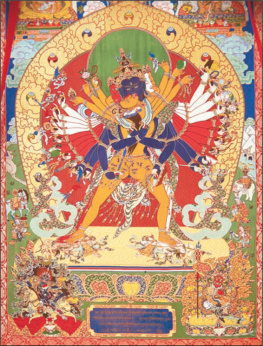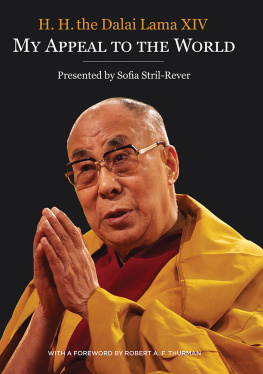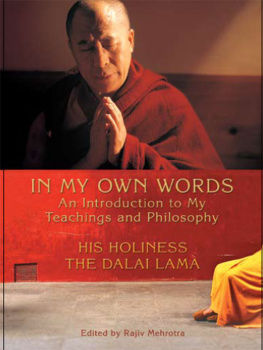Publishers Acknowledgment
The Publisher gratefully acknowledges the generous help of the Hershey Family Foundation in sponsoring the printing of this book.
THE PLACEMENT OF THE KLACHAKRA TANTRA IN THE BUDDHIST VEHICLES
Buddha, a teacher skilled in method, taught eighty-four thousand bundles of doctrine in accordance with the dispositions and interests of trainees. As Maitreyas Ornament for the Great Vehicle Stras (theg pa chen poi mdo sde rgyan, mahyna-strlakra, XI.a) says, The scriptural collections are either three or two. Buddhas many scriptures can be included into the three scriptural collections sets of discourses, discipline, and manifest knowledge or into the scriptures of the two vehicles the Lesser Vehicle of Hearers and Solitary Realizers and the Great Vehicle of Bodhisattvas. The differentiation between these two vehicles is by way of vastness of thought, that is, of motivation; due to it there is a difference also in path, or method; due to that there is, in turn, a difference in the fruit that is attained. This is how the two vehicles are distinguished.
Concerning the Great Vehicle or Vehicle of Bodhisattvas itself, its sub-divisions the Perfection Vehicle and the Mantra Vehicle both require the motivational attitude of altruism and the practice of the six perfections, and both lead to the attainment of the fruit, which is unsurpassed enlightenment. Nevertheless, the two sub-divisions of the Great Vehicle Stra and Mantra are posited as separate vehicles by way of the profundity of the means for attaining unsurpassed enlightenment; the two thereby differ in the body of the path for attaining the omniscience of Buddhahood. From between these two vehicles, what is being explained here is the Mantra Vehicle.
With regard to mantra, according to the Vajrapajara Tantra, an explanatory tantra, there are four sets of tantras, although other texts speak of various divisions of the tantras into six sets, five sets, and so forth. When four are described, they are Action, Performance, Yoga and Highest Yoga Tantra. Among the four tantra sets, Action Tantra is so called because in its practice of yoga there is more emphasis, relative to the other tantra sets, on external activities of ritual bathing and maintaining cleanliness even though internal meditative stabilization is indeed cultivated. Performance Tantra is so called because of there being equal performance of external activities and internal yoga. Yoga Tantra is so called because between external activities and internal yoga, the latter is principally emphasized. Highest Yoga Tantra [literally, Unsurpassed Yoga Tantra] is so called in that since it exceeds even Yoga Tantra in terms of principally emphasizing internal yoga, there is nothing superior to it. What is being explained here in this initiation is Highest Yoga Tantra.
In general, all the tantra systems have as their basis the attitude of altruistic mind generation and the deeds of the six perfections, which are described in the Perfection Vehicle. The distinctive feature of the Secret Mantra Vehicle comes in terms of additional techniques for quickly developing the meditative stabilization that is a union of calm abiding and special insight one-pointed meditative stabilization realizing emptiness. This mainly is achieved through deity yoga.
From one point of view, tantra is more powerful than sutra in terms of collecting merit in that yoga is sustained within visualizing ones body as divine. From another point of view, there also is a difference between the Perfection and Mantra Vehicles in terms of the subject, or substratum, the selflessness of which one is realizing in meditation. For, here in Mantra, one realizes the emptiness not of a gross phenomenon such as an ordinary body but rather of a subtle phenomenon that is appearing to ones internal mind a divine body. This mode of procedure of the path in which there is a yoga of non-duality of the profound and the manifest the manifest being imaginative observation of a circle, or mandala, of deities and the profound being the wisdom realizing suchness is the general path in the three lower tantras Action, Performance, and Yoga Tantras.
Highest Yoga Tantra, in addition to all these features of the Perfection Vehicle and the three lower tantras, has special techniques for concentrated focusing on important points of the body, through which more subtle levels of mind are manifested and transformed into entities of the path. The uncommon profound distinction of all types of Highest Yoga Tantra texts the distinctive feature in terms of which the uncommon potency of the Highest Yoga Tantra path is developed is in the explanation of practices for generating the fundamental innate mind of clear light as an entity of the path.
As techniques for manifesting the fundamental innate mind of clear light, some Highest Yoga Tantra texts speak of concentrated focusing on the winds [or internal currents] of the body; some put emphasis on the four joys; and others speak of merely sustaining non-conceptual meditation. The Guhyasamja Tantra, for instance, speaks mainly of putting concentrated focusing on the winds; the Chakrasavara Tantra and the Hevajra Tantra speak mainly of the four joys; and the technique of manifesting the clear light by way of non-conceptual meditation is mainly found in the great completeness (rdzogs chen) of the 
 ying-ma Order and the great seal (phyag rgya chen po, mahmudr) tradition of the
ying-ma Order and the great seal (phyag rgya chen po, mahmudr) tradition of the 
 a-gyu-
a-gyu-
 a Order. All of these are modes of practice described in valid and reliable source-texts within Highest Yoga Tantra.
a Order. All of these are modes of practice described in valid and reliable source-texts within Highest Yoga Tantra.
To become fully enlightened as a Buddha, it is necessary to practice Mantra and, within Mantra, Highest Yoga Mantra; otherwise, it is not possible to attain Buddhahood. The reason for this is that to actualize the effect state of the two bodies of a Buddha Form Body and Truth Body it is necessary meditatively to cultivate a path that accords in aspect with those two bodies. Even in the Perfection Vehicle, it is necessary to achieve a cause that is concordant with the effect. The main point is that in order to attain the Form Body of a Buddha it is necessary to have a substantial cause of similar type for a Form Body; also, for the Truth Body it is necessary to have a substantial cause of similar type. Since this is the case, our coarse body, which is a fruition [of past karma], cannot serve as a substantial cause of similar type for a Buddhas Form Body. Also, the mentally imagined divine body that appears to a yogi practicing Yoga Tantra, Performance Tantra, or Action Tantra cannot serve as a substantial cause of similar type for a Buddhas Form Body, nor can even an actual body achieved, for instance, through the practice of Yoga Tantra.
What can serve as such a substantial cause of a Form Body? A Buddhas body is one undifferentiable entity with that Buddhas mind; the form [or body] that is of one undifferentiable entity with a Buddhas subtle mind cannot be a coarse form. The Form Body that is of one undifferentiable entity with a Buddhas subtle mind is itself a very subtle entity, and thus as its substantial cause of similar type a body that has a very subtle nature must be achieved at the time of the path. In Highest Yoga Tantra, this is achieved (1) in the Guhyasamja system by way of an illusory body, (2) in the Klachakra system by way of empty form, or (3) in mother tantras by way of a rainbow body of light. Without such a mode of achieving a subtle body at the time of the path, a Buddhas Form Body cannot be achieved.
Next page

















